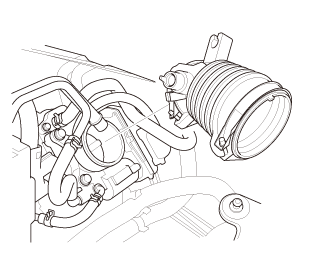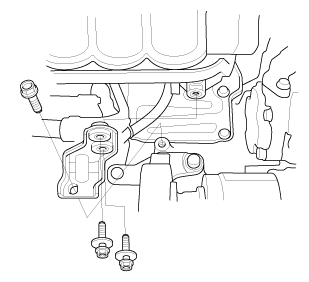Honda Civic Service Manual: Engine Oil Jet and Bolt Inspection (R18A9)

Removal
| 1. | Intake Manifold and Throttle Body Assembly (Natural Gas Model) |
|
|
|
|
|
|
|
|
|
|
|
|
|
|
|
| 2. | Engine Wire Harness |
|
|
|
| 3. | Automatic Transmission Assembly (A/T) |
|
|
|
| 4. | Drive Plate Assembly |
|
|
|
| 5. | A/F Sensor (Sensor 1) |
|
|
|
| 6. | Exhaust Chamber Cover (Natural Gas Model) |
|
|
|
| 7. | Catalytic Converter (Natural Gas Model) |
|
|
|
| 8. | Thermostat Housing (Natural Gas Model) |
|
|
|
| 9. | Alternator |
|
|
|
| 10. | Lower Torque Rod Bracket (A/T) |
|
|
|
| 11. | Intermediate Shaft Assembly |
|
|
|
|
|
|
||||||
| 12. | A/C Compressor Bracket |
|
|
|
| 13. | Water Pump Pulley |
|
|
|
| 14. | Auto Tensioner Assembly |
|
|
|
| 15. | Cylinder Head Cover and/or Packing |
|
|
|
|
|
|
| 16. | Check The No.1 Piston at Top Dead Center (With Cam Chain Case/Oil Pump) |
|
|
|
| 17. | Crankshaft Pulley |
|
|
|
| 18. | Engine Oil Pump Assembly |
|
|
|
|
|
|
| 19. | Cam Chain Auto-Tensioner |
|
|
|
||||||||||||
|
|
|
|
|
|
||||||||||||
|
|
|
| 20. | Cam Chain |
|
|
|
| 21. | Cylinder Head Assembly |
|
|
|
| 22. | Oil Pan Assembly |
|
|
|
|
|
|
| 23. | Engine Oil Strainer |
|
|
|
| 24. | Engine Baffle Plate |
|
|
|
| 25. | Connecting Rod Cap and The Bearing Half |
|
|
|
| 26. | Cylinder Lower Block Assembly |
|
|
|
|
|
|
|
|
|
|
|
|
| 27. | Crankshaft |
|
|
|
| 28. | Engine Oil Jet |
|
|
|
 Inspection
Inspection
| 1. | Engine Oil Jet and Bolt - Inspection |
|
|
|
||||||||||||||||||

Installation
| 1. | Engine Oil Jet |
|
|
|
| 2. | Crankshaft |
|
|
|
||||||
|
|
|
| 3. | Main Bearing Clearance Inspection |
|
|
|
||||||||||||||||||||||||||
|
|
|
||||||||||||||||||||
| 4. | Crankshaft Main Bearing - Selection |
|
|
|
|
|
|
|
|
|
|||||||||||||||||
| 5. | Cylinder Lower Block Assembly |
|
|
|
|||||||||||||||||||||||
|
|
|
|
|
|
|
|
|
|
|
|
|||||||||||||||||
| 6. | Connecting Rod Bearing Clearance Inspection |
|
|
|
|||||||||||||||||||||||||||||||||||||||||||
| 7. | Connecting Rod Bearing Selection |
|
1. |
Inspect each connecting rod for cracks and heat damage. |
 redandrunisind
redandrunisind
|
2. |
Each connecting rod has a tolerance range from 0 to 0.024 mm (0.00094 in), in 0.006 mm (0.00024 in) increments, depending on the size of its big end bore. It's then stamped with a number or bar (1, 2, 3, or 4/l, ll, lll, or llll) indicating the range. You may find any combination of numbers and bars in any engine. (Half the number or bar is stamped on the rod cap, the other half is on the connecting rod.) If you cannot read the code because of an accumulation of oil and varnish, do not scrub it with a wire brush or scraper. Clean it only with solvent or detergent. |
|||||
|
||||||
|
|
|
|
|
|
|||||||||||||||||
| 8. | Connecting Rod Cap and The Bearing Half |
|
|
|
|
|
|
|||||||||
| 9. | Engine Baffle Plate |
|
|
|
| 10. | Engine Oil Strainer |
|
|
|
| 11. | Oil Pan Assembly |
|
|
|
|||||||||||||||||||||||
|
|
|
|
|
|
|||||||||||||||||
| 12. | Cylinder Head Assembly |
|
|
|
|
|
|
|
|
|
|
|
|
||||||
| 13. | Set The No.1 Piston at Top Dead Center (Without Cam Chain Case/Oil Pump) |
|
|
|
| 14. | Cam Chain |
|
|
|
|
|
|
|
|
|
| 15. | Cam Chain Auto-Tensioner |
|
|
|
||||||
|
|
|
|
|
|
| 16. | Engine Oil Pump Assembly |
|
|
|
||||||||||||||||||||||||||
|
|
|
||||||||||||||
|
|
|
||||||||||||||||||||||||||||||
| 17. | Crankshaft Oil Seal, Transmission side |
|
|
|
|
|
|
||||||||||
| 18. | Crankshaft Pulley |
|
|
|
|
|
|
|
|
|
|||||||||||||
|
|
|
||||||||||
| 19. | Valve Clearance Adjustment |
|
|
|
|
2. |
Select the correct feeler gauge for the valve clearance you are going to check. |
|||||||||
|
||||||||||
 no!
no!
|
|
|
|
|
|
|||||||||||||||
|
|
|
|
|
|
|
|
|
| 20. | Cylinder Head Cover and/or Packing |
|
|
|
|||||||||||||||
|
|
|
||||||||||||||||||||
|
|
|
||||||||||||||||||||
|
|
|
| 21. | Auto Tensioner Assembly |
|
|
|
| 22. | Water Pump Pulley |
|
|
|
| 23. | A/C Compressor Bracket |
|
|
|
| 24. | Intermediate Shaft Assembly |
|
|
|
||||||
|
|
|
| 25. | Lower Torque Rod Bracket (A/T) |
|
|
|
| 26. | Alternator |
|
|
|
| 27. | Thermostat Housing (Natural Gas Model) |
|
|
|
| 28. | Catalytic Converter (Natural Gas Model) |
|
|
|
| 29. | Exhaust Chamber Cover (Natural Gas Model) |
|
|
|
| 30. | A/F Sensor (Sensor 1) |
|
|
|
| 31. | Drive Plate Assembly |
|
|
|
| 32. | Automatic Transmission Assembly (A/T) |
|
|
|
| 33. | Engine Wire Harness |
|
|
|
| 34. | Intake Manifold and Throttle Body Assembly (Natural Gas Model) |
|
|
|
|
|
|
|
|
|
|
|
|
|
|
|
 Engine Oil Jet and Bolt Inspection (K24Z7)
Engine Oil Jet and Bolt Inspection (K24Z7)
1.
Warm Up The Engine
1.
Warm up the engine.
2.
Vehicle Lift
...
 Engine Oil Jet and Bolt Inspection (R18Z1)
Engine Oil Jet and Bolt Inspection (R18Z1)
Removal
1.
Intake Manifold and Throttle Body Assembly
1.
Remove the intake air duct.
...
See also:
Honda Civic Owners Manual. Collision Mitigation Braking SystemTM (CMBSTM)
Can assist you when there is a possibility of your vehicle colliding with a
vehicle or a
pedestrian detected in front of yours. The CMBSTM is designed to alert you when
a
potential collision is determined, as well as to reduce your vehicle speed to
help
minimize collision severity when a co ...























 [av
[av


















 in!
in!
 u.75mm
u.75mm



 na.nono
na.nono nojournal
nojournal bunamvllluwgemam,inwmam;
bunamvllluwgemam,inwmam;



 (pulley
(pulley a.ndendam,amznvllred/pink/pinkvellawpink/emwnbrawnsmnllevmd
a.ndendam,amznvllred/pink/pinkvellawpink/emwnbrawnsmnllevmd



 mm
mm


 inmmam
inmmam
 secounstep
secounstep


 ...,is(1.2
...,is(1.2
 nokvf-in.
nokvf-in.


 25mm(7(32k1n1omm12
25mm(7(32k1n1omm12




 o7jaanmo2oa
o7jaanmo2oa











 inl.25mmssn-m
inl.25mmssn-m

 inmmn-mu.o
inmmn-mu.o mms.
mms. u.z5mm75n-mmm
u.z5mm75n-mmm
 imm
imm :1mm.....
:1mm.....

 55
55 usmmn-mlbml)
usmmn-mlbml)


